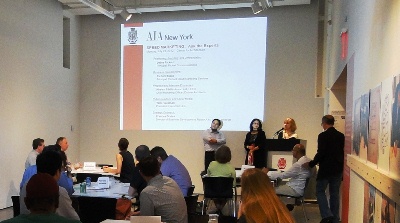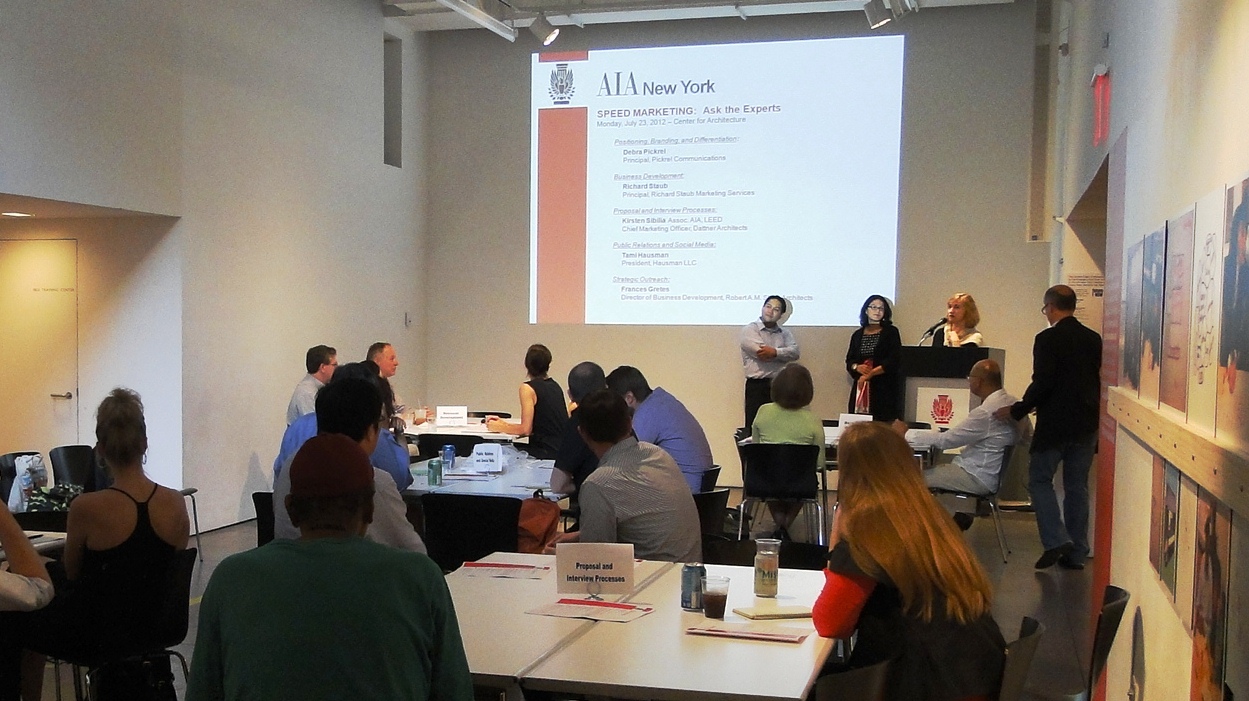by: Linda G. Miller

Berit Hoff
Event: Speed Marketing: Ask the Experts
Location: Center for Architecture, 07.23.12
Topics and leaders: Positioning, Branding, and Differentiation: Debra Pickrel, Principal, Pickrel Communications; Business Development: Richard Staub, Principal, Richard Staub Marketing Services; Proposal and Interview Processes: Kirsten Sibilia, Assoc. AIA, LEED AP, Chief Marketing Officer, Dattner Architects; Public Relations and Social Media: Tami Hausman, President, Hausman LLC; Strategic Outreach: Frances Gretes, Director of Business Development, Robert A.M. Stern Architects
At large: Ileana LaFontaine, Marketing & Design Consultant; Gretchen Bank, Assoc. AIA, Director of Business Development, Cosentini Associates & Co-chair, AIANY Marketing & PR Committee; John Fontillas, AIA, Partner, H3 Hardy Collaboration Architecture & Co-chair, AIANY Marketing & PR Committee
Organizer: AIANY Marketing & PR Committee
Marketing and public relations are essential to large and small practices. But not being an exact art or science, they are one of the least understood components of a successful firm. “Speed Marketing: Ask the Experts” drew participants ranging from architects – particularly those at start-ups – to marketing and PR practitioners who work in-house for AEC firms, and those who have firms as clients.
Attendees started at one of five tables led by a pro, each one representing the various elements of marketing and public relations, for a half-hour discussion. Participants then circulated to another topic table.
Since we can all glean something from the experts, listed below in the first section are what I consider to be the most important top tips from each topic leader. After that is a fuller set of tips from the participants.
My suggestion is to start conceptually at the Positioning, Branding, and Differentiation table, followed in order by Public Relations and Social Media, Business Development, the Proposal and Interview Process, and then Strategic Outreach. There is obviously overlap, but all of the experts agreed that the foundation of a firm’s marketing and PR effort is a strong “elevator pitch” and a solid understanding of “who you are and why you are different from other firms,” and being able to fluidly verbalize it. In fact, each of the experts included this tip in one form or another.
• Branding, Positioning, and Differentiation: The two hallmarks of a great brand are what make you unique and relevant. Know how to explain your firm’s expertise, its culture, values, and team members. Know what you want to say about your firm’s work and how it relates to the clients you are targeting.
• Public Relations and Social Media: Tell good stories. There’s no better way to engage people. Consider that every project has multiple stories and many audiences. Get creative.
• Business Development: The core of this area is relationship-building. There are three parts to the process: the initial contact and introduction;, developing the relationship and the trust that comes with it; and the sell. Everyone gets the first part. It’s the other two that tend to be neglected.
• Proposal and Interview Processes: If your firm does not win the competition or commission, try to get a debriefing to learn what you can improve. And have an honest conversation in-house about what you could have done differently in the proposal/interview process, focusing on the value of what you learned.
• Strategic Outreach: Maximize the use of your presentations. Repackage and disseminate your talk as a podcasts, webinars, white papers, or brochures, and post it on your website and distribute through social media.
And now for the more fulsome tips from the night’s topic leaders:
Positioning, Branding, and Differentiation – Debra Pickrel
• Write and practice your brand elevator speech over and over. It answers the ubiquitous question, “So, tell me about yourself/your firm,” and aim for no longer than a minute. In your answer include who you/your firm are, what makes you unique, and why is this relevant. Make sure you mention three recent successes.
• Study what your competition is doing and saying to shape your brand language differently and with more impact. Use short, succinct, powerful words, and remember we live in a 140-character world now. Use high-powered visuals and videos that portray you in the best light.
• Confront potential roadblocks head-on. This might elucidate a clearer understanding of where you actually want to go, the resistance to stating a position due to ego or other factors, or funding needed to update a website or create a new site entirely.
• Fish where your fish are, so to speak, and don’t try to be all things to all people.
Public Relations and Social Media – Tami Hausman
• Develop a good strategy before you start any outreach program. You need to be clear about why you’re doing it and what you want to accomplish.
• News gets old fast, so be timely and take advantage of good news, whether it’s about a project or a person. Seize opportunities that come your way and make the most of them.
• Social media has expanded the opportunities to promote your work, people, and ideas. Don’t let the medium overcome the message. Make sure your content is appealing and timely.
• Focus on your client’s needs. Think about the publications they read and what they want to hear. That way, your outreach is targeted and accurate.
Business Development – Richard Staub
• Before reaching out, be very clear regarding what your firm is about, what differentiates it, and how it provides value. Have that internalized so that it comes to mind easily in a conversation.
• Establish yourself and your firm as a value provider as you develop the relationship. Demonstrate that you understand the other person’s concerns and priorities.
• Build your comfort level with the process by doing research on the people and institutions you’re reaching out to. If you are calling someone for the first time, use LinkedIn to see if you have a friend in common who will recommend you or can tell you something about the person to whom you wish to contact.
Proposal and Interview Process – Kirsten Sibilia, Assoc. AIA, LEED AP
• Understand the differences between writing a proposal for the public and private sectors.
• Draft the cover letter of a proposal first; describe in a few paragraphs the expertise that your firm provides that is specifically relevant to the project, and your excitement about the assignment. That becomes a touchstone as you develop a compelling narrative to support it throughout your proposal.
• A proposal is a reflection of the quality of design your firm can deliver, so it’s imperative that it is thoughtful, well-designed, and free of typos.
• If appropriate, invite the potential client to visit your office so they can experience your office culture.
Strategic Outreach – Frances Gretes
• Be the only architect on the program. Propose to speak where you are featured as the only expert.
• Research and target venues where your expected audience is most likely to include prospective clients. Look at attendee lists, past programs, and publicity about past programs. Also speak “outside of the box” at associations or to groups that cross into a different field but have related interests.
• Direct your topic to a particular need or interest of your target audience rather than on self-promotion.
Linda G. Miller is a contributing editor to Oculus and e-Oculus.











